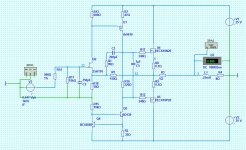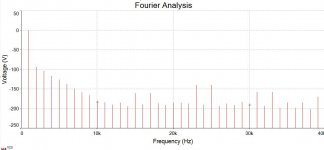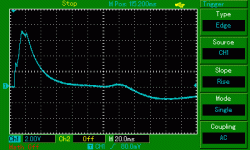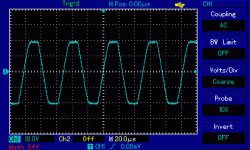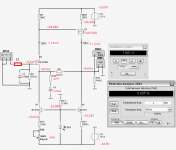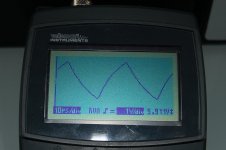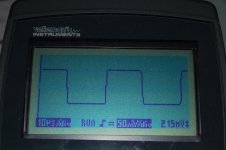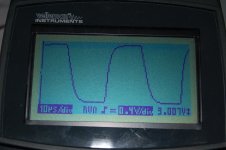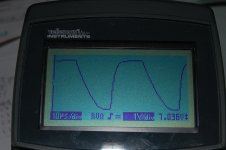are you sure that those LEDs won't add some noise which will spoil the benefits in other areas ?
I remember SY mentioned something about using LEDs in a phono preamp when the subject of noise produced from LEDs came up in the Blowtorch thread. I think in an amp it is likely not an issue.
Hugh... I do think that all like the same.. that we agree on what is good and not good...but also that the conditions around the "listening" may change the outcome....problem is that wee try to evaluate something good (amplifiers) through something bad...(speakers). But again its also the only thing I really Trust is all ears...
Michael,
I'm not so sure everyone likes the same. I think there is a range of tastes out there; some like a smooth sound, some like lots of soft bass, some like hugely tight, loud bass, etc. I think this is one of the reasons there are such schools in audio; some rhapsodize about tube amps, some love single ended mosfets, others like huge SS push pull amps.
However, that said, I suspect there is room for all types under the sun....
Cheers,
Hugh
I'm not so sure everyone likes the same. I think there is a range of tastes out there; some like a smooth sound, some like lots of soft bass, some like hugely tight, loud bass, etc. I think this is one of the reasons there are such schools in audio; some rhapsodize about tube amps, some love single ended mosfets, others like huge SS push pull amps.
However, that said, I suspect there is room for all types under the sun....
Cheers,
Hugh
jkeny,
One is small losses. The 2SJ79 discussed earlier implies very high losses (and for that reason high distortion).Sorry if this has been covered before but what are the important characteristics needed for the VAS device?
Iv'e been investigating what factors influence achieving low broadband HD and I think Swordfishy should be awarded a prize for extreme accurate hearing.
Here are my broad findings
To achieve very low level HD across the whole spectrum 2K - 40K these seem to be the keys points.
1) Bias the o/p stage to about 1amp
2) Bias the VAS to about 20mA
3) Bias the i/p stage to about 8mA ( by reducing the size of the FB resistors to about 10 & 150 ohms ) This increases OLG to over 100dB - which from SWF's comments is the sound he likes. 25 & 375 is also good.
100 & 1500 ohms gives OLG just over 90dB still nice but more HD, more relaxed, more stable - probably a matter of preference
That's it !
There are other methods that MiiB is following but it seems we can have a very simple cct and very low broadband HD.
My testing was only done in a DC linked cct so adjustments may need to be made - but I feel sure the principals remain sound.
All my tests were done at 10V peak which is as loud as I tend to go.
here is the circuit
Here are my broad findings
To achieve very low level HD across the whole spectrum 2K - 40K these seem to be the keys points.
1) Bias the o/p stage to about 1amp
2) Bias the VAS to about 20mA
3) Bias the i/p stage to about 8mA ( by reducing the size of the FB resistors to about 10 & 150 ohms ) This increases OLG to over 100dB - which from SWF's comments is the sound he likes. 25 & 375 is also good.
100 & 1500 ohms gives OLG just over 90dB still nice but more HD, more relaxed, more stable - probably a matter of preference
That's it !
There are other methods that MiiB is following but it seems we can have a very simple cct and very low broadband HD.
My testing was only done in a DC linked cct so adjustments may need to be made - but I feel sure the principals remain sound.
All my tests were done at 10V peak which is as loud as I tend to go.
here is the circuit
Attachments
Last edited:
. . . and here is the Fourier.
I don't necessarily trust the figures absolutely but I do tend to trust the trends that spice indicates, and all of the measures I list above had a significant effect on lowering the HD noise floor.
I cannot imagine wanting better performance than this:
I don't necessarily trust the figures absolutely but I do tend to trust the trends that spice indicates, and all of the measures I list above had a significant effect on lowering the HD noise floor.
I cannot imagine wanting better performance than this:
Attachments
You did not remove the emitter resistor of IRF9610. 47 Ohm
I think this would lower THD a little bit.
I see you use 200pF-99 Ohm for compensation. From VAS to source of 2SK170
This is certainly needed when we go for highest OLG
Do you think is necessary with 0.1 Ohm resistors in output?
I think this would lower THD a little bit.
I see you use 200pF-99 Ohm for compensation. From VAS to source of 2SK170
This is certainly needed when we go for highest OLG
Do you think is necessary with 0.1 Ohm resistors in output?
You did not remove the emitter resistor of IRF9610. 47 Ohm
I like some degeneration and I don't think we need less HD !
Some people might prefer more
Do you think is necessary with 0.1 Ohm resistors in output?
not sure - just an old habit.
Well, your circuit is surely close to ultimate Fetzilla.
Is for those who want low THD distortion amp.
The compensation cap may inreality need to be increased somewhat.
I did see this happen with Danspy's amplifier.
My sim gave one cap value, but i reality was 4 times higher.
Is for those who want low THD distortion amp.
The compensation cap may inreality need to be increased somewhat.
I did see this happen with Danspy's amplifier.
My sim gave one cap value, but i reality was 4 times higher.
The next challenge, Gentlemen, is to remove switch on transients.
This is a tough one..... presently there is about a +7.5V spike at turn on which is unacceptable.
Yes. I was going to ask about that, because, I hate it when that happens. I think a good amp should have zero audible turn on/off thump. I guess it can be tough, with the caps to be charged up.
I was done building amps, but this one intrigues me enough that I am considering switching out one of my other amp boards. I'd use this one for mid/highs in a multi-amped system.
Sheldon
Well, your circuit is surely close to ultimate Fetzilla.
Is for those who want low THD distortion amp.
The compensation cap may inreality need to be increased somewhat.
I did see this happen with Danspy's amplifier.
My sim gave one cap value, but i reality was 4 times higher.
Sorry I but don't think the compensation was the Problem, id is the 2sk30ATM that takes only 100mW power dissipation at 25°.
And that for the Current through the JFet could not go much higher den 1.5mA at 28Volt.
Just in case you're wondering where Hugh got his turn on thump figure...
Measured thump into about 7.2R for AC coupled version with bootstrap VAS.
I must say, it's not as audible as you might expect. I have heard worse. Unless it's causing damage I am not bothered at all. It's all over in 40 milliseconds.
Measured thump into about 7.2R for AC coupled version with bootstrap VAS.
I must say, it's not as audible as you might expect. I have heard worse. Unless it's causing damage I am not bothered at all. It's all over in 40 milliseconds.
Attachments
Doesn't bother me either, in fact I like that sound, it reminds of of my old valve radio and other audio systems from my childhood.
But, my best suggestion to loose it would be to add voltage doublers for the i/p & VAS stages like MiiB suggested and then add resistors that feed the current into two very big caps that cause the voltage to rise slowly for those stages.
That should work, or at lease make any movement subsonic.
But, my best suggestion to loose it would be to add voltage doublers for the i/p & VAS stages like MiiB suggested and then add resistors that feed the current into two very big caps that cause the voltage to rise slowly for those stages.
That should work, or at lease make any movement subsonic.
An update
All,
Thanks for a the nice comments some have made over the last few days. I'm still pursuing the ultimate sound but haven't been doing much as I'm waiting on some special parts.
I have a quick update and a few comments though.
1) I have tried the output stage with IRFP240 and IRFP9240 vertical fets at 1.5A bias. I have only had a little listening time, but so far I see no sonic advantage. In fact, if anything, I think the lateral fets at 0.5A - 1.0A bias sound better. Will update in a few days after more time listening.
2) The turn on thump might look bad, but in reality I have never heard it over my large 20A toggle switch. It really doesn't bother me at all.
3) Here's a shot of how the amp clips, for general interest.
All,
Thanks for a the nice comments some have made over the last few days. I'm still pursuing the ultimate sound but haven't been doing much as I'm waiting on some special parts.
I have a quick update and a few comments though.
1) I have tried the output stage with IRFP240 and IRFP9240 vertical fets at 1.5A bias. I have only had a little listening time, but so far I see no sonic advantage. In fact, if anything, I think the lateral fets at 0.5A - 1.0A bias sound better. Will update in a few days after more time listening.
2) The turn on thump might look bad, but in reality I have never heard it over my large 20A toggle switch. It really doesn't bother me at all.
3) Here's a shot of how the amp clips, for general interest.
Attachments
Some experiments with different MOSFET
Hi all,
I build the lineup's recommended version of Fetzilla, with some minor changes (pic.1).
First at all, I ordered the IRF9610 but I have not got it yet.
Whilst I am waiting for the parts, I tried the IRF4905 (-55V/74A/Ciss=3400pF), the result was pretty poor with the 18.5kHz square wave. (pic.2).
I then tried FQP5P20 (-200V/4.8A/Ciss=330pF), it improved the rise time a bit.
Source (pic.3); Output@3V-pp (pic.4) & Output@7V-pp (pic.5).
Hopefully the IRF9610 (-200V/1.8A/Ciss=170pF) will improve the rise time.
Cheers, Stanley
Hi all,
I build the lineup's recommended version of Fetzilla, with some minor changes (pic.1).
First at all, I ordered the IRF9610 but I have not got it yet.
Whilst I am waiting for the parts, I tried the IRF4905 (-55V/74A/Ciss=3400pF), the result was pretty poor with the 18.5kHz square wave. (pic.2).
I then tried FQP5P20 (-200V/4.8A/Ciss=330pF), it improved the rise time a bit.
Source (pic.3); Output@3V-pp (pic.4) & Output@7V-pp (pic.5).
Hopefully the IRF9610 (-200V/1.8A/Ciss=170pF) will improve the rise time.
Cheers, Stanley
Attachments
Last edited:
- Status
- This old topic is closed. If you want to reopen this topic, contact a moderator using the "Report Post" button.
- Home
- Amplifiers
- Solid State
- JFET input, MOSFET VAS, LATERAL output = Perfect!!
